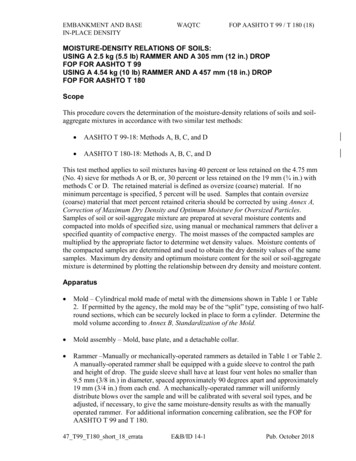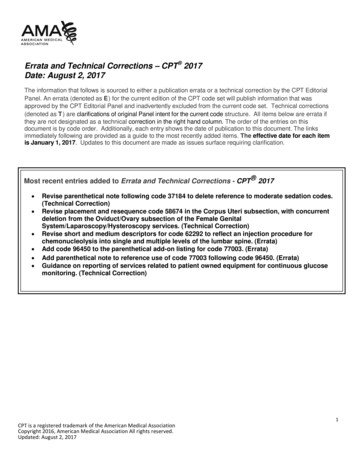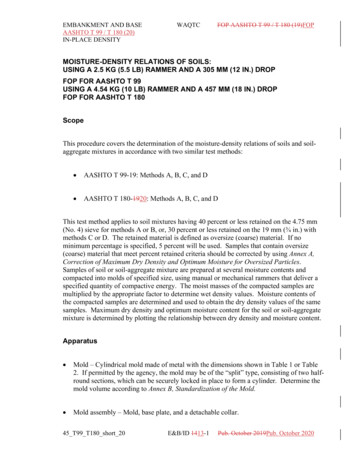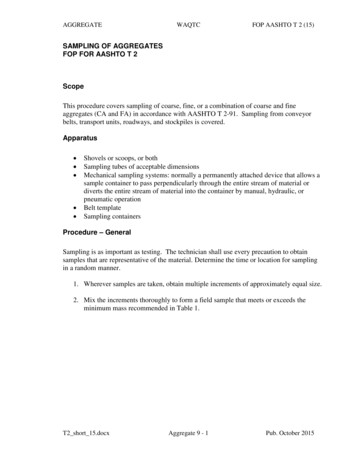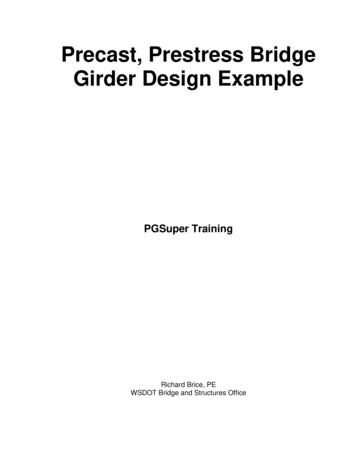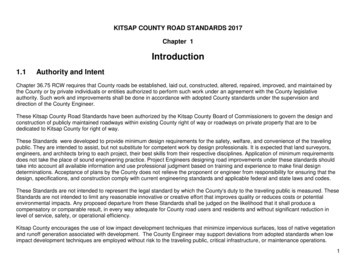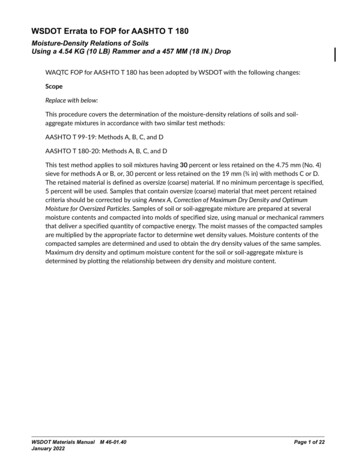
Transcription
WSDOT Errata to FOP for AASHTO T 180Moisture-Density Relations of SoilsUsing a 4.54 KG (10 LB) Rammer and a 457 MM (18 IN.) DropWAQTC FOP for AASHTO T 180 has been adopted by WSDOT with the following changes:ScopeReplace with below:This procedure covers the determination of the moisture-density relations of soils and soilaggregate mixtures in accordance with two similar test methods:AASHTO T 99-19: Methods A, B, C, and DAASHTO T 180-20: Methods A, B, C, and DThis test method applies to soil mixtures having 30 percent or less retained on the 4.75 mm (No. 4)sieve for methods A or B, or, 30 percent or less retained on the 19 mm (¾ in) with methods C or D.The retained material is defined as oversize (coarse) material. If no minimum percentage is specified,5 percent will be used. Samples that contain oversize (coarse) material that meet percent retainedcriteria should be corrected by using Annex A, Correction of Maximum Dry Density and OptimumMoisture for Oversized Particles. Samples of soil or soil-aggregate mixture are prepared at severalmoisture contents and compacted into molds of specified size, using manual or mechanical rammersthat deliver a specified quantity of compactive energy. The moist masses of the compacted samplesare multiplied by the appropriate factor to determine wet density values. Moisture contents of thecompacted samples are determined and used to obtain the dry density values of the same samples.Maximum dry density and optimum moisture content for the soil or soil-aggregate mixture isdetermined by plotting the relationship between dry density and moisture content.WSDOT Materials ManualJanuary 2022M 46-01.40Page 1 of 22
T 180Page 2 of 22WSDOT Materials Manual M 46-01.40January 2022
T 180EMBANKMENT AND BASEIN-PLACE DENSITYWAQTCFOP AASHTO T 99 / T 180 (21)MOISTURE-DENSITY RELATIONS OF SOILS:USING A 2.5 KG (5.5 LB) RAMMER AND A 305 MM (12 IN.) DROPFOP FOR AASHTO T 99USING A 4.54 KG (10 LB) RAMMER AND A 457 MM (18 IN.) DROPFOP FOR AASHTO T 180ScopeThis procedure covers the determination of the moisture-density relations of soils and soilaggregate mixtures in accordance with two similar test methods: AASHTO T 99-21: Methods A, B, C, and D AASHTO T 180-21: Methods A, B, C, and DThis test method applies to soil mixtures having 40 percent or less retained on the 4.75 mm(No. 4) sieve for methods A or B, or 30 percent or less retained on the 19 mm (¾ in.) sievewith methods C or D. The retained material is defined as oversize (coarse) material. If nominimum percentage is specified, 5 percent will be used. Samples that contain oversize(coarse) material that meet percent retained criteria should be corrected by using Annex A,Correction of Maximum Dry Density and Optimum Moisture for Oversized Particles.Samples of soil or soil-aggregate mixture are prepared at several moisture contents andcompacted into molds of specified size, using manual or mechanical rammers that deliver aspecified quantity of compactive energy. The moist masses of the compacted samples aremultiplied by the appropriate factor to determine wet density values. Moisture contents ofthe compacted samples are determined and used to obtain the dry density values of the samesamples. Maximum dry density and optimum moisture content for the soil or soil-aggregatemixture is determined by plotting the relationship between dry density and moisture content.Apparatus Mold – Cylindrical mold made of metal with the dimensions shown in Table 1 or Table2. If permitted by the agency, the mold may be of the “split” type, consisting of two halfround sections, which can be securely locked in place to form a cylinder. Determine themold volume according to Annex B, Standardization of the Mold. Mold assembly – Mold, base plate, and a detachable collar. Rammer – Manually or mechanically operated rammers as detailed in Table 1 or Table 2.A manually operated rammer shall be equipped with a guide sleeve to control the pathand height of drop. The guide sleeve shall have at least four vent holes no smaller than9.5 mm (3/8 in.) in diameter, spaced approximately 90 degrees apart and approximately19 mm (3/4 in.) from each end. A mechanically operated rammer will uniformlydistribute blows over the sample and will be calibrated with several soil types, and beadjusted, if necessary, to give the same moisture-density results as with the manuallyoperated rammer. For additional information concerning calibration, see the FOP forAASHTO T 99 and T 180.45 T99 T180 short 21 errataWSDOT Materials ManualJanuary 2022M 46-01.40E&B/ID 13-1Pub. October 2021Page 3 of 22
T 180EMBANKMENT AND BASEIN-PLACE DENSITYWAQTCFOP AASHTO T 99 / T 180 (21) Sample extruder – A jack, lever frame, or other device for extruding compactedspecimens from the mold quickly and with little disturbance. Balance(s) or scale(s) of the capacity and sensitivity required for the procedure used bythe agency.A balance or scale with a capacity of 11.5 kg (25 lb) and a sensitivity of 1 gfor obtaining the sample, meeting the requirements of AASHTO M 231,Class G 5.A balance or scale with a capacity of 2 kg and a sensitivity of 0.1 g is used formoisture content determinations done under both procedures, meeting therequirements of AASHTO M 231, Class G 2. Drying apparatus – A thermostatically controlled drying oven, capable of maintaining atemperature of 110 5 C (230 9 F) for drying moisture content samples in accordancewith the FOP for AASHTO T 255/T 265. Straightedge – A steel straightedge at least 250 mm (10 in.) long, with one beveled edgeand at least one surface plane within 0.1 percent of its length, used for final trimming. Sieve(s) – 4.75 mm (No. 4) and/or 19.0 mm (3/4 in.), meeting the requirements of FOPfor AASHTO T 27/T 11. Mixing tools – Miscellaneous tools such as a mixing pan, spoon, trowel, spatula, etc., or asuitable mechanical device, for mixing the sample with water. Containers with close-fitting lids to prevent gain or loss of moisture in the sample.45 T99 T180 short 21 errataPage 4 of 22E&B/ID 13-2Pub. October 2021WSDOT Materials Manual M 46-01.40January 2022
T 180EMBANKMENT AND BASEIN-PLACE DENSITYWAQTCFOP AASHTO T 99 / T 180 (21)Table 1Comparison of Apparatus, Sample, and Procedure – MetricMold Volume, m3Mold Diameter, mmMold Height, mmDetachable Collar Height, mmRammer Diameter, mmRammer Mass, kgRammer Drop, mmLayersBlows per LayerMaterial Size, mmTest Sample Size, kgT 99Methods A, C: 0.000943 0.000014Methods B, D: 0.002124 0.000025Methods A, C: 101.60 0.40Methods B, D: 152.40 0.70116.40 0.5050.80 0.6450.80 0.252.495 0.0093053Methods A, C: 25Methods B, D: 56Methods A, B: 4.75 minusMethods C, D: 19.0 minusMethod A: 3Method C: 5 (1)T 180Methods A, C: 0.000943 0.000014Methods B, D: 0.002124 0.000025Methods A, C: 101.60 0.4Methods B, D: 152.40 0.70116.40 0.5050.80 0.6450.80 0.254.536 0.0094575Methods A, C: 25Methods B, D: 56Methods A, B: 4.75 minusMethods C, D: 19.0 minusMethod B: 7Method D: 11(1)Energy, kN-m/m35922,693(1) This may not be a large enough sample depending on your nominal maximum size for moisture contentsamples.Table 2Comparison of Apparatus, Sample, and Procedure – EnglishMold Volume, ft3Mold Diameter, in.Mold Height, in.Detachable Collar Height, in.Rammer Diameter, in.Rammer Mass, lbRammer Drop, in.LayersBlows per LayerMaterial Size, in.Test Sample Size, lbT 99Methods A, C: 0.0333 0.0005Methods B, D: 0.07500 0.0009Methods A, C: 4.000 0.016Methods B, D: 6.000 0.0264.584 0.0182.000 0.0252.000 0.0255.5 0.02123Methods A, C: 25Methods B, D: 56Methods A, B: No. 4 minusMethods C, D: 3/4 minusMethod A: 7Method C: 12(1)T 180Methods A, C: 0.0333 0.0005Methods B, D: 0.07500 0.0009Methods A, C: 4.000 0.016Methods B, D: 6.000 0.0264.584 0.0182.000 0.0252.000 0.02510 0.02185Methods A, C: 25Methods B, D: 56Methods A, B: No.4 minusMethods C, D: 3/4 minusMethod B: 16Method D: 25(1)Energy, lb-ft/ft312,37556,250(1) This may not be a large enough sample depending on your nominal maximum size for moisture contentsamples.45 T99 T180 short 21 errataWSDOT Materials ManualJanuary 2022M 46-01.40E&B/ID 13-3Pub. October 2021Page 5 of 22
T 180EMBANKMENT AND BASEIN-PLACE DENSITYWAQTCFOP AASHTO T 99 / T 180 (21)SampleIf the sample is damp, dry it until it becomes friable under a trowel. Drying may be in air orby use of a drying apparatus maintained at a temperature not exceeding 60 C (140 F).Thoroughly break up aggregations in a manner that avoids reducing the natural size ofindividual particles.Obtain a representative test sample of the mass required by the agency by passing thematerial through the sieve required by the agency. See Table 1 or Table 2 for test samplemass and material size requirements.In instances where the material is prone to degradation, i.e., granular material, a compactionsample with differing moisture contents should be prepared for each point.If the sample is plastic (clay types), it should stand for a minimum of 12 hours after theaddition of water to allow the moisture to be absorbed. In this case, several samples atdifferent moisture contents should be prepared, put in sealed containers, and tested the nextday.Note 1: Both T 99 and T 180 have four methods (A, B, C, D) that require different masses and employdifferent sieves.ProcedureDuring compaction, rest the mold firmly on a dense, uniform, rigid, and stable foundation, orbase. This base shall remain stationary during the compaction process.1. Determine the mass of the clean, dry mold. Include the base plate but exclude theextension collar. Record the mass to the nearest 1 g (0.005 lb).2. Thoroughly mix the selected representative sample with sufficient water to dampen it toapproximately 4 to 8 percentage points below optimum moisture content. For manymaterials, this condition can be identified by forming a cast by hand.a. Prepare individual samples of plastic or degradable material, increasing moisturecontents 1 to 2 percent for each point.b. Allow samples of plastic soil to stand for 12 hrs.3. Form a specimen by compacting the prepared soil in the mold assembly in approximatelyequal layers. For each layer:a. Spread the loose material uniformly in the mold.Note 2: It is recommended to cover the remaining material with a non-absorbent sheet or damp cloth tominimize loss of moisture.b. Lightly tamp the loose material with the manual rammer or other similar device, thisestablishes a firm surface.c. Compact each layer with uniformly distributed blows from the rammer. See Table 1for mold size, number of layers, number of blows, and rammer specification for thevarious test methods. Use the method specified by the agency.d. Trim down material that has not been compacted and remains adjacent to the walls ofthe mold and extends above the compacted surface.45 T99 T180 short 21 errataPage 6 of 22E&B/ID 13-4Pub. October 2021WSDOT Materials Manual M 46-01.40January 2022
T 180EMBANKMENT AND BASEIN-PLACE DENSITYWAQTCFOP AASHTO T 99 / T 180 (21)4. Remove the extension collar. Avoid shearing off the sample below the top of the mold.The material compacted in the mold should not be over 6 mm (¼ in.) above the top of themold once the collar has been removed.5. Trim the compacted soil even with the top of the mold with the beveled side of thestraightedge.6. Clean soil from exterior of the mold and base plate.7. Determine and record the mass of the mold, base plate, and wet soil to the nearest 1 g(0.005 lb) or better.8. Determine and record the wet mass (Mw) of the sample by subtracting the mass in Step 1from the mass in Step 7.9. Calculate the wet density (ρw), in kg/m3 (lb/ft3), by dividing the wet mass by themeasured volume (Vm).10. Extrude the material from the mold. For soils and soil-aggregate mixtures, slice verticallythrough the center and remove one of the cut faces for a representative moisture contentsample. For granular materials, a vertical face will not exist. Take a representativesample ensuring that all layers are represented. This sample must meet the sample sizerequirements of the test method used to determine moisture content.Note 3: When developing a curve for free-draining soils such as uniform sands and gravels, where seepageoccurs at the bottom of the mold and base plate, taking a representative moisture content from the mixingbowl may be preferred in order to determine the amount of moisture available for compaction.11. Determine and record the moisture content of the sample in accordance with the FOP forAASHTO T 255 / T 265.12. If the material is degradable or plastic, return to Step 3 using a prepared individualsample. If not, continue with Steps 13 through 15.13. Thoroughly break up the remaining portion of the molded specimen until it will againpass through the sieve, as judged by eye, and add to the remaining portion of the samplebeing tested.14. Add sufficient water to increase the moisture content of the remaining soil by 1 to 2percentage points and repeat steps 3 through 11.45 T99 T180 short 21 errataWSDOT Materials ManualJanuary 2022M 46-01.40E&B/ID 13-5Pub. October 2021Page 7 of 22
T 180EMBANKMENT AND BASEIN-PLACE DENSITYWAQTCFOP AASHTO T 99 / T 180 (21)15. Continue determinations until there is either a decrease or no change in the wet mass.There will be a minimum of three points on the dry side of the curve and two points onthe wet side. For non-cohesive, drainable soils, one point on the wet side is sufficient.CalculationsWet Density𝜌𝜌 Where:𝑀𝑀 𝑉𝑉 ρw wet density, kg/m3 (lb/ft3)Mw wet massVm volume of the mold, Annex B𝜌𝜌 𝜌𝜌 100𝑤𝑤 100Dry Density𝑜𝑜𝑜𝑜 𝜌𝜌 Where:𝜌𝜌 𝑤𝑤 1100ρd dry density, kg/m3 (lb/ft3)w moisture content, as a percentageExample for 4-inch mold, Methods A or CWet mass, Mw 1.928 kg (4.25 lb)Moisture content, w 11.3%Measured volume of the mold, Vm 0.000946 m3 (0.0334 ft3)Wet Density𝜌𝜌 1.928 𝑘𝑘𝑘𝑘4.25 𝑙𝑙𝑙𝑙 2038𝑘𝑘𝑘𝑘𝑘𝑘𝜌𝜌 127.2 𝑙𝑙𝑙𝑙 𝑙𝑙𝑙𝑙 0.000946 𝑚𝑚 0.0334 𝑓𝑓𝑓𝑓 45 T99 T180 short 21 errataPage 8 of 22E&B/ID 13-6Pub. October 2021WSDOT Materials Manual M 46-01.40January 2022
T 180EMBANKMENT AND BASEIN-PLACE DENSITYWAQTCFOP AASHTO T 99 / T 180 (21)Dry Density𝜌𝜌 Or2038 𝑘𝑘𝑘𝑘 𝑘𝑘 127.2 𝑙𝑙𝑙𝑙 𝑙𝑙𝑙𝑙 100 1831 𝑘𝑘𝑘𝑘 𝑘𝑘 𝜌𝜌 100 114.3 𝑙𝑙𝑙𝑙 𝑙𝑙𝑙𝑙 11.3 10011.3 100𝜌𝜌 2038 𝑘𝑘𝑘𝑘 𝑘𝑘 127.2 𝑙𝑙𝑙𝑙 𝑙𝑙𝑙𝑙 1831 𝑘𝑘𝑘𝑘 𝑘𝑘 𝜌𝜌 114.3 𝑙𝑙𝑙𝑙 𝑙𝑙𝑙𝑙 11.311.3 1 1100100Moisture-Density Curve DevelopmentWhen dry density is plotted on the vertical axis versus moisture content on the horizontalaxis and the points are connected with a smooth line, a moisture-density curve is developed.The coordinates of the peak of the curve are the maximum dry density, or just “maximumdensity,” and the “optimum moisture content” of the soil.ExampleGiven the following dry density and corresponding moisture content values develop amoisture-density relations curve and determine maximum dry density and optimum moisturecontent.Dry 6.912.81869116.713.61857115.914.245 T99 T180 short 21 errataWSDOT Materials ManualJanuary 2022Moisture Content, %M 46-01.40E&B/ID 13-7Pub. October 2021Page 9 of 22
T 180EMBANKMENT AND BASEIN-PLACE DENSITYWAQTCFOP AASHTO T 99 / T 180 (21)x1900x118.0Maximum Dry Density 1880 kg/m 3 (117.3 lbs/ft3)Optimum Moisture 13.2%x1880xDry Density lb/ft33xx116.01860xDry Density kg/m117.0115.01860x114.01820x113.010 %11 %12 %13 %Moisture Content (%)14 %15 %16 %In this case, the curve has its peak at:Maximum dry density 1880 kg/m3 (117.3 lb/ft3)Optimum moisture content 13.2%Note that both values are approximate since they are based on sketching the curve to fit thepoints.Report Results on forms approved by the agency Sample ID Maximum dry density to the nearest 1 kg/m3 (0.1 lb/ft3) Optimum moisture content to the nearest 0.1 percent45 T99 T180 short 21 errataPage 10 of 22E&B/ID 13-8Pub. October 2021WSDOT Materials Manual M 46-01.40January 2022
T 180EMBANKMENT AND BASEIN-PLACE DENSITYWAQTCFOP AASHTO T 99 / T 180 (21)ANNEX ACORRECTION OF MAXIMUM DRY DENSITY AND OPTIMUM MOISTURE FOROVERSIZED PARTICLES(Mandatory Information)This section corrects the maximum dry density and moisture content of the material retainedon the 4.75 mm (No. 4) sieve, Methods A and B; or the material retained on the 19 mm(¾ in.) sieve, Methods C and D. The maximum dry density, corrected for oversized particlesand total moisture content, are compared with the field-dry density and field moisturecontent.This correction can be applied to the sample on which the maximum dry density isperformed. A correction may not be practical for soils with only a small percentage ofoversize material. The agency shall specify a minimum percentage below which the methodis not needed. If not specified, this method applies when more than 5 percent by weight ofoversize particles is present.Bulk specific gravity (Gsb) of the oversized particles is required to determine the correctedmaximum dry density. Use the bulk specific gravity as determined using the FOP forAASHTO T 85 in the calculations. For construction activities, an agency established valueor specific gravity of 2.600 may be used.This correction can also be applied to the sample obtained from the field while performingin-place density.Procedure1. Use the sample from this procedure or a sample obtained according to the FOP forAASHTO T 310.2. Sieve the sample on the 4.75 mm (No. 4) sieve for Methods A and B or the 19 mm (¾ in.)sieve, Methods C and D.3. Determine the dry mass of the oversized and fine fractions (MDC and MDF) by one of thefollowing:a. Dry the fractions, fine and oversized, in air or by use of a drying apparatus that ismaintained at a temperature not exceeding 60ºC (140ºF).b. Calculate the dry masses using the moisture samples.To determine the dry mass of the fractions using moisture samples.1.Determine the moist mass of both fractions, fine (MMf) and oversized (MMc):2.Obtain moisture samples from the fine and oversized material.3.Determine the moisture content of the fine particles (MCf) and oversized particles(MCC) of the material by FOP for AASHTO T 255/T 265 or agency approvedmethod.4.Calculate the dry mass of the oversize and fine particles.45 T99 T180 short 21 errataWSDOT Materials ManualJanuary 2022M 46-01.40E&B/ID 13-9Pub. October 2021Page 11 of 22
T 180EMBANKMENT AND BASEIN-PLACE DENSITYWAQTC𝑀𝑀 Where:FOP AASHTO T 99 / T 180 (21)𝑀𝑀 1 MCMD mass of dry material (fine or oversize particles)Mm mass of moist material (fine or oversize particles)MC moisture content of respective fine or oversized, expressed as a decimalCalculate the percentage of the fine (Pf) and oversized (Pc) particles by dry weightof the total sample as follows: See Note 2.5.𝑃𝑃 And𝑃𝑃 100 𝑀𝑀 𝑀𝑀 𝑀𝑀 100 𝑀𝑀 𝑀𝑀 𝑀𝑀 Or for Pc:100 15.4 𝑙𝑙𝑙𝑙 73%15.4 𝑙𝑙𝑙𝑙 5.7 𝑙𝑙𝑙𝑙100 5.7 𝑙𝑙𝑙𝑙 27%15.4 𝑙𝑙𝑙𝑙 5.7 𝑙𝑙𝑙𝑙100 6.985 𝑘𝑘𝑘𝑘 73%6.985 𝑘𝑘𝑘𝑘 2.585 𝑘𝑘𝑘𝑘100 2.585𝑘𝑘𝑘𝑘 27%6.985 𝑘𝑘𝑘𝑘 2.585 𝑘𝑘𝑘𝑘𝑃𝑃 100 𝑃𝑃 Where:Pf percent of fine particles, of sieve used, by weightPc percent of oversize particles, of sieve used, by weightMDF mass of dry fine particlesMDC mass of dry oversize particles45 T99 T180 short 21 errataPage 12 of 22E&B/ID 13-10Pub. October 2021WSDOT Materials Manual M 46-01.40January 2022
T 180EMBANKMENT AND BASEIN-PLACE DENSITYWAQTCFOP AASHTO T 99 / T 180 (21)Optimum Moisture Correction Equation1. Calculate the corrected moisture content as follows:𝑀𝑀𝑀𝑀 𝑀𝑀𝑀𝑀 𝑃𝑃 𝑀𝑀𝑀𝑀 𝑃𝑃 100 13.2% 73.0% 2.1% 27.0% 10.2%100MCT corrected moisture content of combined fines and oversized particles,expressed as a % moistureMCF moisture content of fine particles, as a % moistureMCC moisture content of oversized particles, as a % moistureNote 1: Moisture content of oversize material can be assumed to be two (2) percent for most constructionapplications.Note 2: In some field applications agencies will allow the percentages of oversize and fine materials to bedetermined with the materials in the wet state.Density Correction Equation2. Calculate the corrected dry density (ρd) of the total sample (combined fine and oversizedparticles) as follows:𝜌𝜌 Where:100%𝑃𝑃 𝑃𝑃 𝜌𝜌 𝑘𝑘ρd corrected total dry density (combined fine and oversized particles)kg/m3 (lb/ft 3)ρf dry density of the fine particles kg/m3 (lb/ft3), determined in the labPc percent of dry oversize particles, of sieve used, by weight.Pf percent of dry fine particles, of sieve used, by weight.k Metric: 1,000 * Bulk Specific Gravity (Gsb) (oven dry basis)of coarse particles (kg/m3).k English: 62.4 * Bulk Specific Gravity (Gsb) (oven dry basis)of coarse particles (lb/ft3)Note 3: If the specific gravity is known, then this value will be used in the calculation. For mostconstruction activities the specific gravity for aggregate may be assumed to be 2.600.45 T99 T180 short 21 errataWSDOT Materials ManualJanuary 2022M 46-01.40E&B/ID 13-11Pub. October 2021Page 13 of 22
T 180EMBANKMENT AND BASEIN-PLACE DENSITYWAQTCFOP AASHTO T 99 / T 180 (21)CalculationExample Metric:Maximum laboratory dry density (ρf):1880 kg/m3Percent coarse particles (Pc):27%Percent fine particles (Pf):73%Mass per volume coarse particles (k):(2.697) (1000) 2697 kg/m3𝜌𝜌 𝜌𝜌 𝜌𝜌 100%𝑃𝑃 𝑃𝑃 𝜌𝜌 𝑘𝑘100%73%27% 1880 𝑘𝑘𝑘𝑘 𝑘𝑘 2697 𝑘𝑘𝑘𝑘 𝑘𝑘 100% 0.03883 𝑘𝑘𝑘𝑘 𝑘𝑘 0.01001 𝑘𝑘𝑘𝑘 𝑘𝑘 𝜌𝜌 2047.5 𝑘𝑘𝑘𝑘 𝑘𝑘 𝑟𝑟𝑟𝑟𝑟𝑟𝑟𝑟𝑟𝑟𝑟𝑟 2048 𝑘𝑘𝑘𝑘 𝑘𝑘 45 T99 T180 short 21 errataPage 14 of 22E&B/ID 13-12Pub. October 2021WSDOT Materials Manual M 46-01.40January 2022
T 180EMBANKMENT AND BASEIN-PLACE DENSITYWAQTCFOP AASHTO T 99 / T 180 (21)English:Maximum laboratory dry density (ρf):117.3 lb/ft3Percent coarse particles (Pc):27%Percent fine particles (Pf):73%Mass per volume of coarse particles (k): (2.697) (62.4) 168.3 lb/ft3𝜌𝜌 𝜌𝜌 𝜌𝜌 100%27%73% 168.3 𝑙𝑙𝑙𝑙 𝑙𝑙𝑙𝑙 117.3 𝑙𝑙𝑙𝑙 𝑙𝑙𝑙𝑙 100% 0.6223 𝑙𝑙𝑙𝑙 𝑙𝑙𝑙𝑙 0.1604 𝑙𝑙𝑙𝑙 𝑙𝑙𝑙𝑙 𝜌𝜌 Report100%𝑃𝑃 𝑃𝑃 𝜌𝜌 𝑘𝑘100%0.7827 𝑙𝑙𝑙𝑙 𝑙𝑙𝑙𝑙 𝜌𝜌 127.76 𝑙𝑙𝑙𝑙 𝑙𝑙𝑙𝑙 𝑅𝑅𝑅𝑅𝑅𝑅𝑅𝑅𝑅𝑅𝑅𝑅 127.8 𝑙𝑙𝑙𝑙 𝑙𝑙𝑙𝑙 On forms approved by the agency Sample ID Corrected maximum dry density to the nearest 1 kg/m3 (0.1 lb/ft3) Corrected optimum moisture to the nearest 0.1 percent45 T99 T180 short 21 errataWSDOT Materials ManualJanuary 2022M 46-01.40E&B/ID 13-13Pub. October 2021Page 15 of 22
T 180EMBANKMENT AND BASEIN-PLACE DENSITYWAQTCFOP AASHTO T 99 / T 180 (21)ANNEX BSTANDARDIZATION OF THE MOLD(Mandatory Information)Standardization is a critical step to ensure accurate test results when using this apparatus.Failure to perform the standardization procedure as described herein will produce inaccurateor unreliable test results.Apparatus Mold and base plate Balance or scale – Accurate to within 45 g (0.1 lb) or 0.3 percent of the test load,whichever is greater, at any point within the range of use. Cover plate – A piece of plate glass, at least 6 mm (1 4 in.) thick and at least 25 mm(1 in.) larger than the diameter of the mold. Thermometers – Standardized liquid-in-glass, or electronic digital total immersion type,accurate to 0.5 C (1 F)Procedure1. Create a watertight seal between the mold and base plate.2. Determine and record the mass of the dry sealed mold, base plate, and cover plate.3. Fill the mold with water at a temperature between 16 C and 29 C (60 F and 85 F) andcover with the cover plate in such a way as to eliminate bubbles and excess water.4. Wipe the outside of the mold, base plate, and cover plate dry, being careful not to loseany water from the mold.5. Determine and record the mass of the filled mold, base plate, cover plate, and water.6. Determine and record the mass of the water in the mold by subtracting the mass in Step 2from the mass in Step 5.7. Measure the temperature of the water and determine its density from Table B1,interpolating, as necessary.8. Calculate the volume of the mold, Vm, by dividing the mass of the water in the mold bythe density of the water at the measured temperature.45 T99 T180 short 21 errataPage 16 of 22E&B/ID 13-14Pub. October 2021WSDOT Materials Manual M 46-01.40January 2022
T 180EMBANKMENT AND BASEIN-PLACE DENSITYWAQTCFOP AASHTO T 99 / T 180 (21)Calculations𝑉𝑉 Where:𝑀𝑀𝜌𝜌 Vm volume of the moldM mass of water in the moldρwater density of water at the measured temperatureExample𝑉𝑉 Mass of water in mold 0.94367 kg (2.0800 lb)ρwater at 23 C (73.4 F) 997.54 kg/m3 (62.274 lb/ft3)0.94367 𝑘𝑘𝑘𝑘 0.000946 𝑚𝑚 997.54 𝑘𝑘𝑘𝑘 𝑘𝑘 C( F)kg/m3𝑉𝑉 2.0800 𝑙𝑙𝑙𝑙 0.0334 𝑓𝑓𝑓𝑓 62.274 𝑙𝑙𝑙𝑙 𝑙𝑙𝑙𝑙 Table B1Unit Mass of Water15 C to 30 C(lb/ft3) C( .65(62.156)45 T99 T180 short 21 errataWSDOT Materials ManualJanuary 2022M 46-01.40E&B/ID 13-15Pub. October 2021Page 17 of 22
T 180EMBANKMENT AND BASEIN-PLACE DENSITYWAQTCFOP AASHTO T 99 / T 180 (21)Report Mold ID Date Standardized Temperature of the water Volume, Vm, of the mold to the nearest 0.000001 m3 (0.0001 ft3)45 T99 T180 short 21 errataPage 18 of 22E&B/ID 13-16Pub. October 2021WSDOT Materials Manual M 46-01.40January 2022
T 180EMBANKMENT AND BASEIN-PLACE DENSITYWAQTCFOP AASHTO T 99/T 180 (18)PERFORMANCE EXAM CHECKLISTMOISTURE-DENSITY RELATION OF SOILSFOP FOR AASHTO T 180Participant NameExam DateRecord the symbols “P” for passing or “F” for failing on each step of the checklist.Procedure ElementTrial 1 Trial 21. If damp, sample dried in air or drying apparatus, not exceeding60 C (140 F)?2. Sample broken up and an adequate amount sieved over the appropriatesieve (4.75 mm / No. 4 or 19.0 mm / 3/4 in.) to determine oversize (coarseparticle) percentage?3. Sample passing the sieve has appropriate mass?a. Multiple samples mixed with water varying moisture content by 1 to2 percent, bracketing the optimum moisture content?b. Samples placed in covered containers and allowed to stand for at least12 hours?6. Sample determined to be 4 to 8 percent below expected optimummoisture content?7. Determine mass of clean, dry mold without collar to nearest 1 g (0.005 lb.)?8. Mold placed on rigid and stable foundation?9. Layer of soil (approximately one fifth compacted depth) placed in moldwith collar attached, loose material lightly tamped?10. Soil compacted with appropriate number of blows (25 or 56)?11. Material adhering to the inside of the mold trimmed?12. Layer of soil (approximately two fifths compacted depth) placed in moldwith collar attached, loose material lightly tamped?13. Soil compacted with appropriate number of blows (25 or 56)?14. Material adhering to the inside of the mold trimmed?15. Layer of soil (approximately three fifths compacted depth) placed in moldwith collar attached, loose material lightly tamped?16. Soil compacted with appropriate number of blows (25 or 56)?4. If material is degradable:a. Multiple samples mixed with water varying moisture contentby 1 to 2 percent, bracketing the optimum moisture content?5. If soil is plastic (clay types):OVER21 T180 pr 18WSDOT Materials ManualJanuary 2022E&B/ID 4-27M 46-01.40Pub. October 2021Page 19 of 22
T 180EMBANKMENT AND BASEIN-PLACE DENSITYWAQTCFOP AASHTO T 99/T 180 (18)Procedure ElementTrial 1 Trial 217. Material adhering to the inside of the mold trimmed?18. Layer of soil (approximately four fifths compacted depth) placed in moldwith collar attached, loose material lightly tamped?19. Soil compacted with appropriate number of blows (25 or 56)?20. Material adhering to the inside of the mold trimmed?21. Mold filled with soil such that compacted soil will be above the mold,loose material lightly tamped?22. Soil compacted with appropriate number of blows (25 or 56)?23. Collar removed without shearing off sample?24. Approximately 6 mm (1/4 in.) of compacted material above thetop of the mold (without the collar)?25. Soil trimmed to top of mold with the beveled side of the straightedge?26. Remove all soil from exterior surface of mold and base plate?27. Mass of mold and contents determined to appropriate precision (1 g)?28. Wet density calculated from the wet mass?29. Soil removed from mold using a sample extruder if needed?30. Soil sliced vertically through center (non-granular material)?31. Moisture sample removed ensuring all layers are represented?32. Moist mass determined immediately to 0.1 g?33. Moisture sample mass of correct size?34. Sample dried, and water content determined according to the FOP forT 255/T 265?35. Remainder of material from mold broken up until it will pass throughthe sieve, as judged by eye, and added to remainder of original test sample?36. Water added to increase moisture content of the remaining samplein approximately 1 to 2 percent increments?37. Steps 2 through 20 repeated for each increment of water added?38. Process continued until wet density either decreases or stabilizes?39. Moisture content and dry density calculated for each sample?40. Dry density plotted on vertical axis, moisture content plotted onhorizontal axis, and points connected with a smooth curve?41. Moisture content at peak of curve recorded as optimum water contentand recorded to nearest 0.1 percent?42. Dry density at optimum moisture content reported as maximum density tonearest 1 kg/m3 (0.1 lb/ft3)?OVER21 T180 pr 18Page 20 of 22E&B/ID 4-28Pub. October 2021WSDOT Materials Manual M 46-01.40January 2022
T 180EMBANKMENT AND BASEIN-PLACE DENSITYWAQTCProcedure ElementTrial 1 Trial 243. Corrected for coarse particles if applicable?Comments:First attempt:FOP AASHTO T 99/T 180 (18)PassFailSecond attempt: PassFailExaminer Signature WAQTC #:21 T180 pr 18WSDOT Materials ManualJanuary 2022E&B/ID 4-29M 46-01.40Pub.
aggregate mixtures in accordance with two similar test methods: AASHTO T 99-19: Methods A, B, C, and D AASHTO T 180-20: Methods A, B, C, and D This test method applies to soil mixtures having 30 percent or less retained on the 4.75 mm (No. 4) sieve for methods A or B, or, 30 percent or less retained on the 19 mm (¾ in) with methods C or D.
